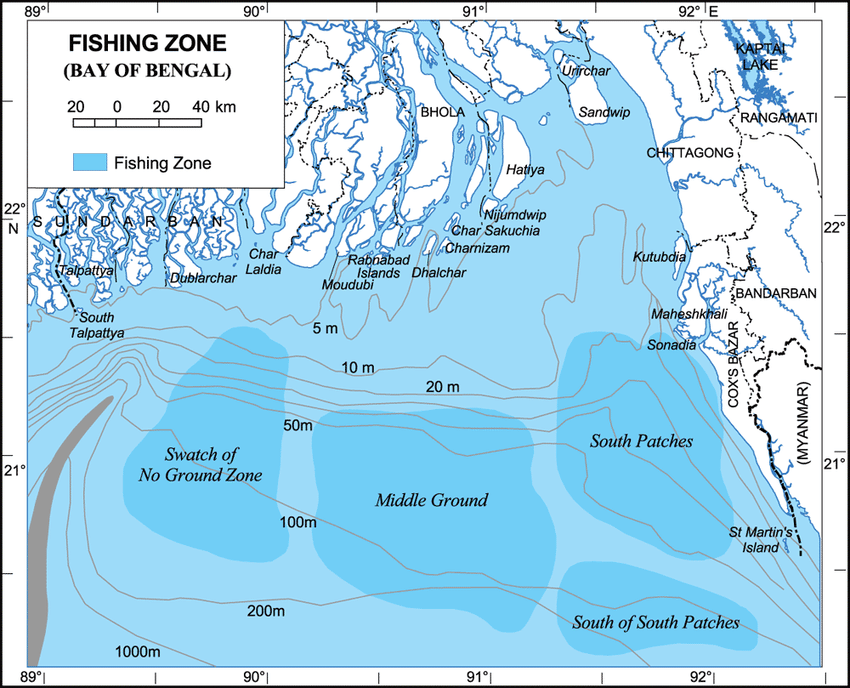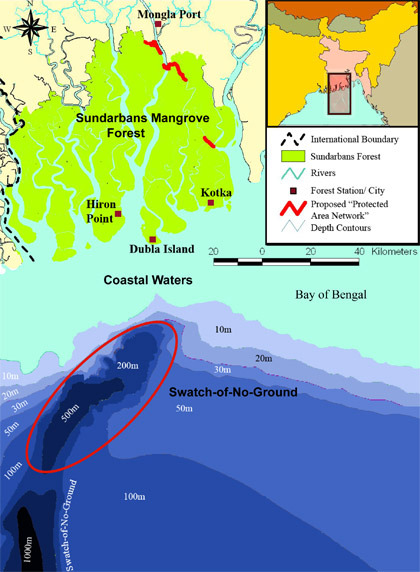Offshore
Offshore or open sea or pelagic ecosystem refers to the environment in the ocean away from the coast above the seabed, introducing a broad range of marine species such as algae, invertebrates and fish. The biodiversity in the offshore environment is vital to many aspects of human well-being, such as supplying food and energy through producing plant biomass from sunlight and nutrients and regulating global climate.
This environment supports a diverse range of benthic habitats, and many important species, from microscopic planktons such as diatoms, dinoflagellates and foraminifera to various species of seabirds and marine mammals. The upper open sea or epipelagic zone is home to all sorts of iconic animals, like whales and dolphins, billfishes, tunas, jellyfish, sharks, and many other groups. Algae that live in the epipelagic zone are responsible for much of the original food production for the entire ocean and create at least 50% of the oxygen in the atmosphere.
Bangladesh is bestowed with immense coastal and marine resources along its south edge at the northernmost part of the Bay of Bengal with the coverage of a marine area of 118,813 sq. km. The coastal and marine ecosystem of Bangladesh is a part of the Bay of Bengal Large Marine Ecosystem which is one of the world’s 64 Large Marine Ecosystems. The Exclusive Economic Zone (EEZ) of the country extends from the baseline to 200 nautical miles seaward.
The unique parameters in near-shore and offshore areas of the country particularly offer a nourished breeding and feeding ground for many brackish and marine water fisheries (Shamsuddoha & Islam, 2016). Some significant faunal species include the Humpback whale (Megaptera novaeangliae), Fin whale (Balaenoptera physalus), Ganges river dolphin (Platanista gangetica), Irrawaddy dolphin (Orcaella breverostris), Indo-Pacific humpback dolphin (Sousa chinensis) (Nishat et al. 2002). Moreover, decapod crustaceans such as shrimps and lobsters swim to the shallow offshore waters to complete their lifecycles. Mature sea turtles migrate towards the offshore area for mating. Moreover, the offshore areas of the Bay of Bengal also serve as a potential reserve of organic sediments. Macroalgae, seagrass and corals provide habitats for many other species such as mollusks, crustaceans and fish whereas kelp forests and seagrass meadows are vital habitats for the fry and juvenile fish.
Four fishing grounds have been identified in the Bay of Bengal area of Bangladesh. These are south patches, south of south patches, middle ground and Swatch of no Ground (Banglapedia 2023). All these fishing grounds are potential reserves for fish and shrimp. Most of the known commercial species of shrimp and fish are harvested from these areas by trawlers or mechanized fishing boats. Commercially important shrimp and fish species include tiger shrimp, karuma shrimp, catfish, Bombay duck, snapper, flounder, Indian salmon, crocker, seabream, jawfish, mullet, pomfret, ribbon fish, anchovy, hilsa, oil sardine, tuna, mackerel and skipjack. A brief description of these fishing grounds is given below as per the given information in Banglapedia (2023):
South patches are located at 91.30’E to 92.10’E and 20.55’S to 21.52’S, having a total area of 3,662 sq km. Depth ranges from 10m to 100m, but 90% of the total area is less than 40m deep. The bottom sediment is sandy or slightly muddy sand. The nearest distance of the ground from Chittagong and Cox’s Bazar is 40 km and 10 km respectively. Salinity in surface water ranges from 26% to 32% and 30% to 35% in bottom water. Water temperature varies between 20 and 28’C.
South of south patches located at 91.30’E to 92.20’E and 20.15’S 20.50’S, having an area of 2,538 sq km. The nearest boundary of this area is 5 km from Teknaf. Depth ranges from 10m to 100m. Within this ground 75% of the area is more than 40m deep. The bottom is sandy or muddy sand. Surface salinity ranges from 18% to 34% and bottom water salinity from 28% to 38%. Water temperature ranges between 22’C and 30’C.

Figure 1: Four major fishing grounds of Bangladesh in the Bay of Bengal
The middle ground is located at 90.20’E to 91.30’E and 20.25’S to 21.20’S, having a total area of about 4,600 sq km. The nearest distance from Cox’s Bazar is about 65 km. The depth of 70% of the total area is more than 40m. The bottom sediment is soft mud or muddy sand. Surface salinity ranges from 22% to 34% and bottom salinity from 28% to 35%. The water temperature is between 26’C and 28’C.
Swatch of no Ground located at 89.35’E to 90.10’E and 20.55’S to 21.55’S, about 30 km away from Dublarchar and 40 km from Sunarchar. The total area is about 3,800 sq km, of which 70% is more than 40m deep. The overall depth of the area ranges from 10m to 100m. The bottom sediment consists of muddy sand. Surface salinity is 28% to 34%, while the bottom salinity is 30% to 35%. Water temperature falls within 24’C to 30’C. It was formed about 125,000 years ago by erosive flows from the Ganges/Padma river system and underwater currents in the Bay of Bengal (WCS, 2015). It is a cone-shaped submarine canyon that incises to within 40 km of the Sundarbans mangrove forest, connected to rivers that contribute to coastal areas of Bangladesh through the deep sea.

Figure 2: Swatch-of-No-Ground in the Bay of Bengal
The Swatch-of-No-Ground (SoNG), is a ‘900+ m deep submarine canyon located in a geographic “cul-de-sac” of the Bay of Bengal’. The Bangladesh government declared the Swatch-of-No-Ground Marine Protected Area (SoNG-MPA), Bangladesh’s first marine protected area, covering 1738 sq. km of marine area in the Bay of Bengal. The SoNG-MPA was declared to conserve the following species of dolphins, porpoises, whales and sharks (Karim and Uddin 2019):
i. Dolphins: Irrawaddy Dolphin, Indo-Pacific Humpbacked Dolphin, Bottle-nosed dolphin, Pantropical Spotted Dolphin, Spinner Dolphin
ii. Porpoise: Finless Porpoise
iii. Whales: Bryde’s Whale, Fin-backed Whale, Humpbacked Whale, Pygmy Sperm Whale, Dwarf Sperm Whale, Killer Whale, False Killer Whale
iv. Sharks: Winghead/Hammerhead Shark, Leopard Shark/Zebra Shark, Spotted Cat Shark, Gray Baboo Shark, Kani Shark, Milk Shark, Blacktop Shark, Silky Shark, Dog Shark/Yellow Dogfish, Fairi Shark, Laretooth Sawfish, Pointed Sawfish
The canyon carries sediments that sustain the world’s largest submarine fan and its cool, upwelled waters may serve as a refuge for cetaceans that cannot adapt to warming ocean temperatures or declines in productivity resulting from climate change. It has now been identified as a cetacean hotspot for globally endangered Irrawaddy dolphins (Orcaella brevirostris), and several other cetaceans. WCS (2015) reported some common cetaceans sighted at SoNG are Irrawaddy dolphins (Orcaella brevirostris), finless porpoises (Neophocaena phocaenoides), Indo-Pacific humpback dolphins (Sousa chinensis), Indo-Pacific bottlenose dolphins (Tursiops aduncus), Bryde’s whales (Balaenoptera edeni/brydei), Spinner dolphins (Stenella longirostris) and Pantropical spotted dolphins (Stenella attenuata). Additionally, seabirds: Greater crested tern (Sterna bergii) Lesser crested tern (Sterna bengalensis) Brown-headed gull (Larus brunnicephalus) Black-headed gull (Larus ridibundus) Common tern (Sterna hirundo) Whiskered tern (Chilidonius hybridus) and other wildlife: Olive Ridley Turtle (Lepidochelys olivacea) Whale shark (Rhincodon typus) were also recorded.
References
Ali Reza AHM, Barua SP, Huq SMI, Khan ASM and Nishat A (2002) Bio-ecological Zones of Bangladesh. IUCN Bangladesh Country Office, Dhaka, Bangladesh, xii+ 131 pp.
Banglapedia (2023) Bay of Bengal. [Accessed on 19 August, 2023] https://en.banglapedia.org/index.php/Bay_of_Bengal
Hoq ME, Yousuf HAK and Chakraborty SC (2013) Marine Fisheries of Bangladesh: Prospect & Potentialities. Support to Sustainable Management of the BOBLME Project, Bangladesh Fisheries Research Institute, Bangladesh. 120 pp.
IUCN-MMPATF (2022) Swatch-of-No-Ground IMMA Factsheet. IUCN Joint SSC/WCPA Marine Mammal Protected Areas Task Force. [Accessed on 19 August, 2013] https://www.marinemammalhabitat.org/wp-content/uploads/imma-factsheets/NorthEastIndianSouthEastAsian/Swatch-of-No-Ground-NorthEastIndianSouthEastAsian.pdf
Karim MS and Uddin MM (2019) Swatch-of-no-ground marine protected area for sharks, dolphins, porpoises and whales: Legal and institutional challenges. Marine Pollution Bulletin, 139: 275–281. https://doi.org/10.1016/j.marpolbul.2018.12.037
Katrien T (2021) Open ocean habitat. [Accessed on 19 August, 2013] http://www.coastalwiki.org/wiki/Open_ocean_habitat
Marine Life Encyclopedia (2023) Marine Science and Ecosystems: Open Ocean. [Accessed on 19 August, 2013] https://oceana.org/marine-life/open-ocean/
Shamsuddoha M and Islam MM (2016) Bangladesh national conservation strategy: coastal and marine resources, Ministry of Environment and Forest.
WCS (2015) Proposal to establish a marine protected area in the Swatch-of-No-Ground submarine canyon and surrounding coastal waters in the Bay of Bengal. Wildlife Conservation Society. Bangladesh Cetacean Diversity Project. [Accessed on 19 August, 2023] https://www.cbd.int/doc/meetings/mar/ebsaws-2015- 01/other/ebsaws-2015-01-gobi-submission6-en.pdf.
World Ocean Review (2010) Living with the oceans: A report on the state of the world’s oceans. [Accessed on 19 August, 2013] https://worldoceanreview.com/en/wor-1/marine-ecosystem/biodiversity/